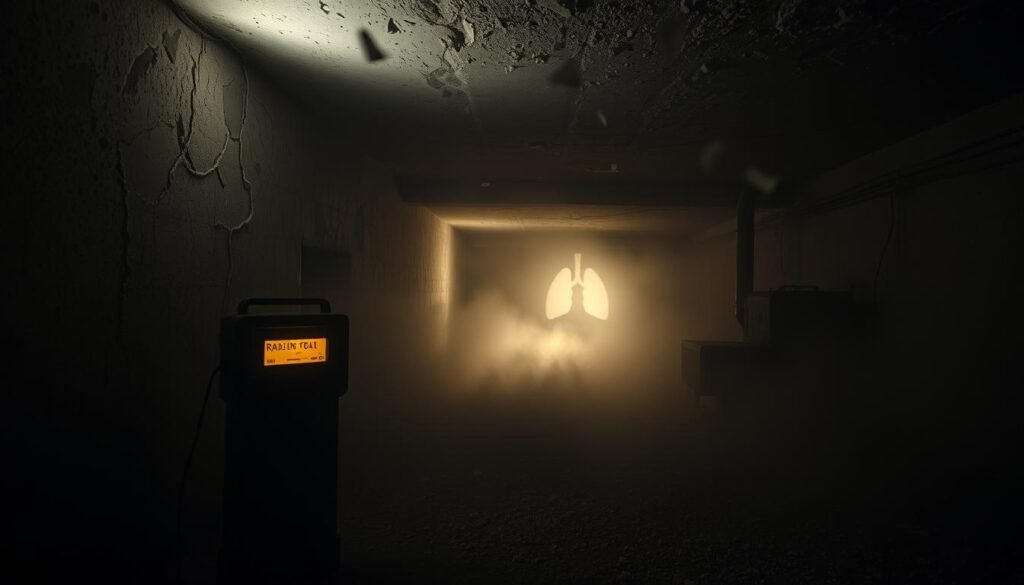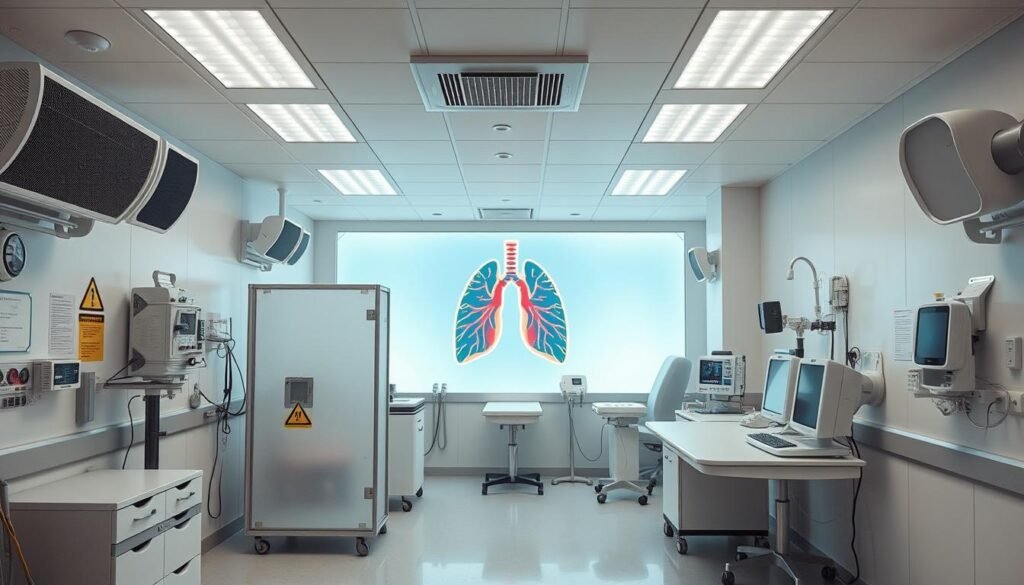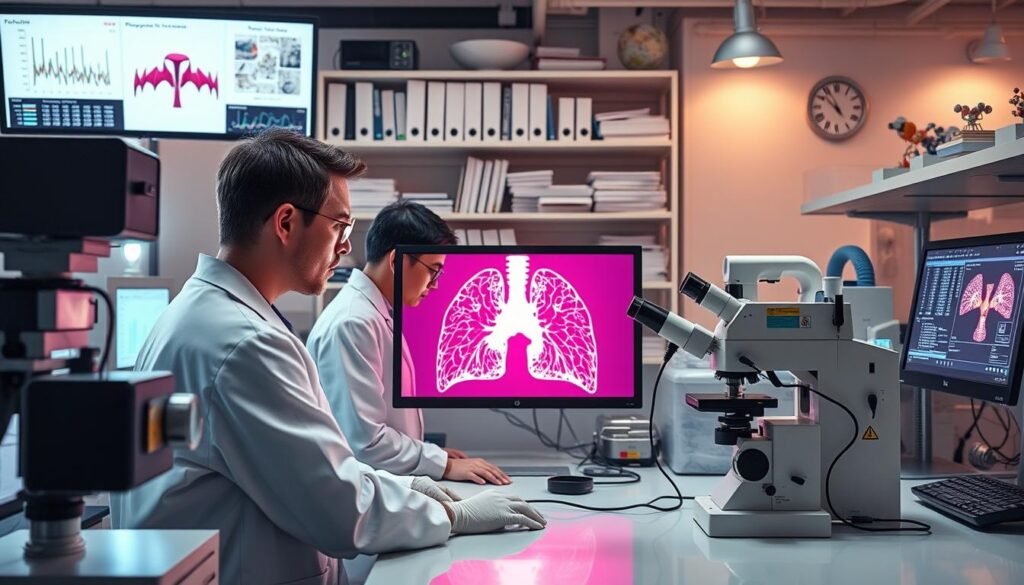Did you know radon is the number two cause of lung cancer in the United States? It’s behind an estimated 15,000 to 22,000 deaths from lung cancer every year. This fact underlines the need to grasp how radiation boosts lung cancer risk. Lung cancer leads in cancer-related deaths worldwide, often with smoking and environmental exposures.
This article will make clear the complicated link between radiation types, especially ionizing radiation, and lung cancer risk. Understanding these links helps people know the dangers of radiation. And it encourages them to act to protect their health.
Key Takeaways
- Radon exposure significantly contributes to lung cancer deaths in the U.S.
- Long-term exposure to radon increases the risk of lung cancer.
- A substantial portion of radon-related lung cancer deaths occurs among nonsmokers.
- Reducing indoor radon levels can prevent thousands of lung cancer deaths each year.
- Ionizing radiation has been confirmed to be linked with cancer development.
- Understanding radiation exposure can help in implementing effective cancer prevention strategies.
Understanding Lung Cancer and Its Causes
Lung cancer is the top cause of cancer deaths worldwide. Its spread varies widely based on smoking and exposure to harmful elements. Knowing the causes is key for lung cancer prevention and treatment.
Overview of Lung Cancer Statistics
In the U.S., smoking is linked to 80% of lung cancer deaths. This number is even higher for small cell lung cancer types. For non-smokers, radon exposure is the second top cause.
People with jobs exposing them to asbestos or diesel exhaust face higher risks. Also, smokers taking beta-carotene supplements increase their lung cancer risk.
Primary Causes of Lung Cancer
Main causes of lung cancer lead to high death rates. Important risk factors are:
- Smoking: Causes about 90 percent of lung cancers.
- Radon Exposure: Responsible for around 30 percent of deaths among non-smokers.
- Asbestos and Occupational Hazards: Especially dangerous for workers who also smoke.
- Radiation Therapy: Past cancer treatments can boost lung cancer risk, more so for smokers.
- Family History: Genetic factors can double lung cancer chances.
The complex nature of lung cancer’s development highlights the need for risk factor awareness. By focusing on prevention, we can greatly lower lung cancer rates.
| Risk Factor | Increased Risk |
|---|---|
| Smoking | Responsible for 90% of lung cancers |
| Radon Exposure | Linked to 30% of non-smoker lung cancer deaths |
| Asbestos | Higher risk for workers and smokers |
| Previous Cancer Radiation Therapy | Increases risk among smokers |
| Family History | Doubles likelihood of lung cancer development |
What Is Radiation Exposure?
Radiation exposure is key in talking about lung cancer risks. Knowing the different kinds of radiation is important. There are two main types: ionizing and non-ionizing radiation.
Types of Radiation: Ionizing vs Non-Ionizing
Ionizing radiation has enough power to remove electrons from atoms. This can damage cells. It includes gamma rays and X-rays, often used in medical images. Non-ionizing radiation, like visible light and radio waves, has lower energy. It’s less worrisome for cancer risk, but still important to know about.
Sources of Radiation Exposure
Natural and man-made sources can expose us to radiation. Naturally, we get about 3 to 5 mSv per year. Cosmic rays and radon gas are big natural sources. Man-made sources, like CT scans, add more. An adult CT scan gives off about 10 mSv. That’s equal to two years of natural radiation.
Knowing these sources helps us understand lung cancer risks better. For info on radiation effects and treatment advancements, check here and here.
How Radiation Exposure Increases Lung Cancer Risk
Scientific studies show radiation exposure and lung cancer are linked. One key study focused on atomic-bomb survivors. This tells us how radiation is a risk for lung cancer.
Scientific Evidence Linking Radiation to Lung Cancer
The Life Span Study (LSS) found a clear link between radiation and lung cancer risk. They looked at over 105,000 people from 1958 to 1999. They found 1,803 lung cancer cases.
For non-smokers exposed to radiation at age 30, the risk increases by age 70. About 7% of lung cancer cases were due to radiation. Smoking was the cause in about one-third of cases. This shows the strong effect of radiation on lung cancer.
The Role of Ionizing Radiation in Cancer Development
Ionizing radiation is known to cause lung cancer. In the LSS study, women had nearly four times the risk than men. Men have a higher lung cancer rate due to more smoking.
Radon and cigarette smoke together raise lung cancer risk more than each alone. This highlights how dangerous radiation can be.
Understanding radiation’s role in cancer is crucial. This knowledge helps public health efforts target high-risk groups better.
Radon Exposure as a Leading Risk Factor
It’s very important to understand radon exposure for public health. This gas comes from uranium decay in soil and rock. It’s a Group 1 carcinogen, linked strongly to cancer, especially lung cancer. Knowing about radon, where it’s found, and its effects is key.
What Is Radon and Where Does It Come From?
Radon gas gathers in closed spaces like homes, schools, and buildings close to the ground. Levels can range from about 10 Bq/m³ to more than 10,000 Bq/m³. It’s often higher in basements or ground-contact areas. The WHO advises keeping indoor radon under 100 Bq/m³ to cut health risks.
Health Risks Associated with Radon Exposure
Radon is a top cause of lung cancer from inhalation over time. Long breathing in radon can cause 3% to 14% of lung cancers. The risk increases about 16% with each 100 Bq/m³ rise in radon. Smokers are at a noticeably higher danger, 25 times more likely to get radon-induced lung cancer. This highlights the urgent need for action, particularly where radon is common.

Combating radon’s health dangers requires continuous watching and action. Using passive systems can cut indoor radon by more than half. Ventilation fans help too. Studies show keeping an eye on radon and educating people can greatly reduce risk from long exposure. For more on radon health risks, check this link.
Occupational Hazards: Workers at Risk
Many workers face significant risks, especially in jobs with a lot of radiation. Some jobs have a high exposure to cancer-causing agents. This leads to an increased risk of lung cancer. Understanding the link between certain jobs and health risks is crucial.
Types of Jobs with Increased Radiation Exposure
Some jobs that often expose workers to radiation are:
- Nuclear industry workers
- Medical radiologists
- Uranium miners
- Workers handling heavy metals such as nickel and arsenic
- Employees in industries utilizing polycyclic aromatic hydrocarbons (PAHs)
These jobs come with their own sets of challenges and dangers. For example, nuclear workers face a higher death rate from solid cancers. This is linked to their cumulative radiation exposure. A big study involving 308,297 nuclear workers from different countries showed worrying cancer death rates.
Case Studies of Occupational Radiation Effects
A study called the Pooled Uranium Miners Analysis looked into radiation exposure and lung cancer deaths among uranium miners. This study found lung cancer deaths increased by 47% per Gy of radiation. These findings highlight the importance of strict safety measures at work.
Other industries also show a link between job exposure and cancer. Workers making rubber face higher risks for bladder and lung cancers. Those in the leather industry have more respiratory cancers. Understanding this link helps in creating ways to protect workers at risk.
To prevent these risks, early detection and safety measures are key. Safety steps can greatly reduce cancer risks from workplace dangers. For more information on the impact of job exposures on health, read this study.
The Impact of Smoking on Radiation-Induced Cancer
The link between smoking and cancer, especially lung cancer, is clear. If you’re exposed to radiation, smoking raises this risk even more. Smoking is the top cause of lung cancer. It also makes treatment, like radiotherapy, less effective. Knowing how smoking and radiation together affect cancer risk is key for better care and preventing cancer.
How Smoking Increases Overall Cancer Risk
Smoking is tied to 13 types of cancer. More than half of people with cancer either smoke now or used to. This shows how big a role smoking plays in cancer. The mix of smoking and radiation is particularly harmful during radiotherapy. Radiotherapy can cure about 40% of cancers. But, its success drops if the patient smokes while getting treatment.
Joint Effects of Smoking and Radiation Exposure
The combined effect of smoking and radiation is especially harmful. Even light smokers face much higher cancer risks when exposed to radiation. The risk only grows for heavy smokers. This shows how vital stop-smoking programs are for those exposed to radiation. Smoking during radiotherapy also increases the chance of getting another type of cancer. This makes lung cancer even more dangerous.
Understanding Radiation Dosage and Risk
Understanding radiation dosage is key in evaluating lung cancer risk. Units like gray (Gy) and sievert (Sv) measure radiation’s impact on health. These units show us how different levels of radiation can affect the body, including increasing cancer risk.
Measuring Radiation Dose: Gray and Sievert Units
Gray units measure radiation absorbed by tissue. Sievert units measure the health impact of that radiation. CT scans and nuclear imaging are big sources of radiation. They contribute to nearly 75% of our radiation exposure. On average, people receive about 2.4 ± 6.0 millisieverts (mSv) per year from these sources.
Interpreting Dosage in Relation to Lung Cancer Risk
It’s crucial to understand how radiation dose affects lung cancer risk. For a 40-year-old woman, the lung cancer risk after 100 mSv is 0.178%. Low doses, between 10 mSv to 100 mSv, are linked to a higher cancer risk. This supports the idea that risk increases with the dose received.
| Radiation Procedure | Effective Dose (mSv) | Comparison to Natural Background |
|---|---|---|
| Single Chest X-ray | 0.1 | 10 days |
| Mammogram | 0.4 | 7 weeks |
| CT Scan (Abdomen and Pelvis) | 10 | 3 years |
| PET/CT | 25 | 8 years |
| Lower GI Series | 8 | 3 years |
This table shows the effective doses from various radiation procedures. It highlights the big differences in exposure levels. This information helps shape public health policies. The aim is to reduce lung cancer risks from radiation.
Radiation Safety Measures to Minimize Risks
Keeping people safe from radiation’s harm is crucial. Good safety steps can greatly lower the dangers of radiation. This is extra important in places where radiation is more common.
Personal and Occupational Safety Guidelines
Using the right safety gear is key in places with lots of radiation. Gear like lead aprons and special shields protect you. Also, devices that check how much radiation you’re around are important.
Workers also need regular training on staying safe. Learning and following safety rules help keep radiation risks low in many jobs.
Regulatory Protections Against Radiation Exposure
The EPA and OSHA set tough rules for radiation safety. These rules protect not just workers, but everyone. Following these rules ensures workplaces are safe and health is watched over.
These steps are very important for keeping workers from harm due to radiation. It shows how regulation and safety practices work together to lessen risks.

Cancer Prevention Strategies for High-Risk Groups
For people at high risk, preventing cancer is key. This is especially true for those who smoke or are around a lot of radon. They have a higher chance of getting lung cancer. But, if they get screened early, they have a better shot at beating it.
Screening Recommendations for At-Risk Populations
Experts suggest certain tests for people more likely to get lung cancer. For example, if you’re 50 or older and have smoked a lot, you should get a CT scan every year. Finding cancer early can make a big difference in treatment success. If lung cancer runs in your family, your risk doubles. People with HIV also have a higher chance of getting lung cancer.
Public Awareness and Education on Radiation Risks
Educating the public about the risks of smoking and radiation helps a lot. It teaches people how dangerous radon can be. By talking about the risks, it encourages people to live healthier. Quitting smoking, for instance, can greatly reduce lung cancer rates. For those exposed to a lot of radon, knowing the risks can lead to a safer home.
| Risk Factors | Relative Risk |
|---|---|
| Tobacco Smoking | 20 times higher for smokers |
| Family History | Twice as likely to develop lung cancer |
| HIV Infection | More than 2 times higher risk |
| Radon Exposure | 26% of lung cancer deaths in non-smokers |
| Occupational Hazards (e.g., asbestos) | Increased risk based on exposure |
| Air Pollution | Higher lung cancer rates in polluted areas |
Ongoing Research in Radiation and Cancer Studies
The study of how radiation exposure might cause lung cancer is important. The Life Span Study shows why it’s key to watch the long-term effects of radiation. This work helps us know more, guiding our health projects.
Latest Findings from the Life Span Study
Recent data from the Life Span Study shed light on radiation’s role in cancer. It points out the risk grows for those exposed to ionizing radiation, like X-rays. Improving our understanding of dose-response relationships is critical to identify risk levels.
The Need for Continued Research and Monitoring
It’s crucial to keep researching to better address the risks of radiation and cancer. Evaluating the combined effects of smoking and radiation is particularly important. Aimed at making effective prevention plans, this research is vital.
Exploring new medical tech’s role in how it changes radiation exposure is necessary. To protect people better, we must consider the impact on specific groups. For more insights, dive into radiation and cancer research.

| Study Aspect | Details |
|---|---|
| Population Evaluated | Individuals exposed to ionizing radiation |
| Increased Risks | Primary lung cancer correlated with higher radiation exposure |
| Key Risk Factors | Smoking and radiation co-exposure |
| Future Directions | Refine models and enhance preventive measures |
Global Health Implications
Radiation exposure impacts public health worldwide. Its effects are deep and broad. Different countries view radiation’s impact through varied lenses. This leads to uneven safety rules and practices. Such inconsistency affects public health, especially with lung cancer. Lung cancer is a top cause of cancer deaths across the globe.
Understanding Radiation Exposure’s Impact Worldwide
The Pooled Uranium Miners Analysis (PUMA) study looked at 118,329 male uranium miners. It found a 23% higher death rate from lung cancer than expected. This shows the need for policies to lower radiation risks.
The Role of Policy in Radiation Exposure Reduction
Policy is key in reducing radiation exposure. Countries have different rules which affect how effective safety measures are. Good policies should focus on:
- Research funding to better understand radiation’s health effects.
- Public health efforts to increase radiation awareness and prevention.
- Safety measures for those working in risky conditions.
Global teamwork is needed to make standards uniform and lessen lung cancer risks from radiation. Working together is the only way to address radiation’s health threats effectively.
Conclusion
Research has shown a clear link between radiation exposure and lung cancer risk. This is a major public health issue. Studies, like the PUMA study, tell us that radon and other radiation forms can greatly raise the chance of getting lung cancer. A 23% increase in cancer deaths has been seen in certain groups. This shows we need to act to lower these risks.
Small amounts of radiation can still be dangerous, especially for kids and those with many imaging tests. It’s important for everyone to know about these dangers. Smoking plus radiation makes cancer risks much higher. We must have good plans to stop this from happening.
We need to keep researching and taking actions to cut down lung cancer from radiation. By working together and teaching people, we can protect future generations. This will lead to a healthier world for all of us.